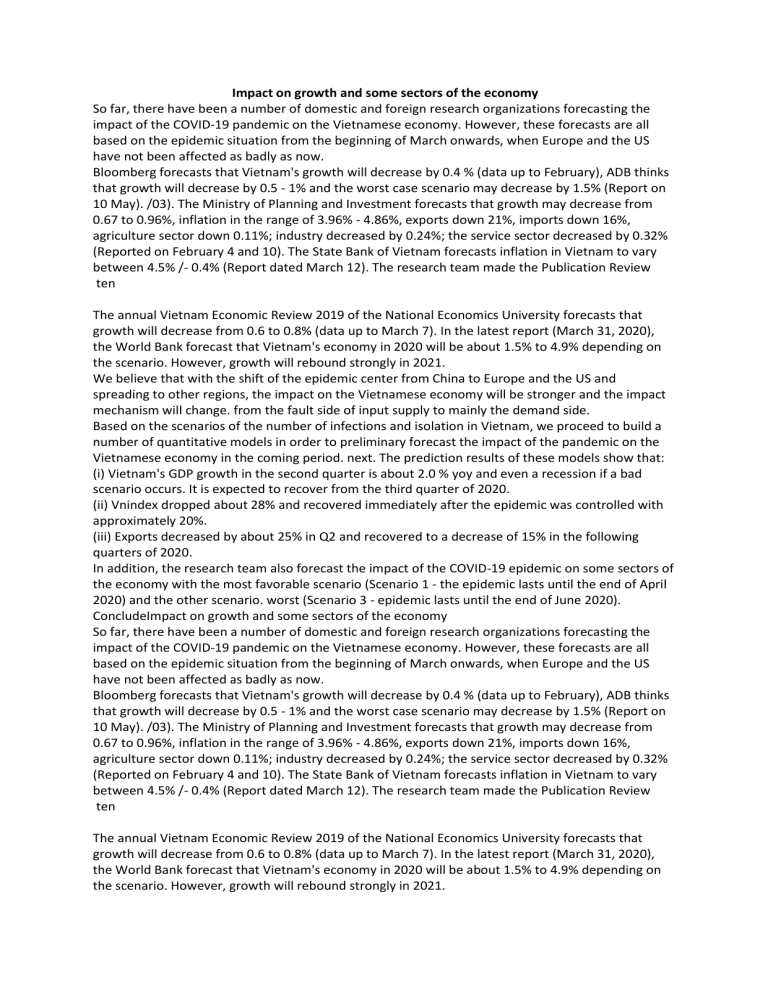
Impact on growth and some sectors of the economy So far, there have been a number of domestic and foreign research organizations forecasting the impact of the COVID-19 pandemic on the Vietnamese economy. However, these forecasts are all based on the epidemic situation from the beginning of March onwards, when Europe and the US have not been affected as badly as now. Bloomberg forecasts that Vietnam's growth will decrease by 0.4 % (data up to February), ADB thinks that growth will decrease by 0.5 - 1% and the worst case scenario may decrease by 1.5% (Report on 10 May). /03). The Ministry of Planning and Investment forecasts that growth may decrease from 0.67 to 0.96%, inflation in the range of 3.96% - 4.86%, exports down 21%, imports down 16%, agriculture sector down 0.11%; industry decreased by 0.24%; the service sector decreased by 0.32% (Reported on February 4 and 10). The State Bank of Vietnam forecasts inflation in Vietnam to vary between 4.5% /- 0.4% (Report dated March 12). The research team made the Publication Review ten The annual Vietnam Economic Review 2019 of the National Economics University forecasts that growth will decrease from 0.6 to 0.8% (data up to March 7). In the latest report (March 31, 2020), the World Bank forecast that Vietnam's economy in 2020 will be about 1.5% to 4.9% depending on the scenario. However, growth will rebound strongly in 2021. We believe that with the shift of the epidemic center from China to Europe and the US and spreading to other regions, the impact on the Vietnamese economy will be stronger and the impact mechanism will change. from the fault side of input supply to mainly the demand side. Based on the scenarios of the number of infections and isolation in Vietnam, we proceed to build a number of quantitative models in order to preliminary forecast the impact of the pandemic on the Vietnamese economy in the coming period. next. The prediction results of these models show that: (i) Vietnam's GDP growth in the second quarter is about 2.0 % yoy and even a recession if a bad scenario occurs. It is expected to recover from the third quarter of 2020. (ii) Vnindex dropped about 28% and recovered immediately after the epidemic was controlled with approximately 20%. (iii) Exports decreased by about 25% in Q2 and recovered to a decrease of 15% in the following quarters of 2020. In addition, the research team also forecast the impact of the COVID-19 epidemic on some sectors of the economy with the most favorable scenario (Scenario 1 - the epidemic lasts until the end of April 2020) and the other scenario. worst (Scenario 3 - epidemic lasts until the end of June 2020). ConcludeImpact on growth and some sectors of the economy So far, there have been a number of domestic and foreign research organizations forecasting the impact of the COVID-19 pandemic on the Vietnamese economy. However, these forecasts are all based on the epidemic situation from the beginning of March onwards, when Europe and the US have not been affected as badly as now. Bloomberg forecasts that Vietnam's growth will decrease by 0.4 % (data up to February), ADB thinks that growth will decrease by 0.5 - 1% and the worst case scenario may decrease by 1.5% (Report on 10 May). /03). The Ministry of Planning and Investment forecasts that growth may decrease from 0.67 to 0.96%, inflation in the range of 3.96% - 4.86%, exports down 21%, imports down 16%, agriculture sector down 0.11%; industry decreased by 0.24%; the service sector decreased by 0.32% (Reported on February 4 and 10). The State Bank of Vietnam forecasts inflation in Vietnam to vary between 4.5% /- 0.4% (Report dated March 12). The research team made the Publication Review ten The annual Vietnam Economic Review 2019 of the National Economics University forecasts that growth will decrease from 0.6 to 0.8% (data up to March 7). In the latest report (March 31, 2020), the World Bank forecast that Vietnam's economy in 2020 will be about 1.5% to 4.9% depending on the scenario. However, growth will rebound strongly in 2021. We believe that with the shift of the epidemic center from China to Europe and the US and spreading to other regions, the impact on the Vietnamese economy will be stronger and the impact mechanism will change. from the fault side of input supply to mainly the demand side. Based on the scenarios of the number of infections and isolation in Vietnam, we proceed to build a number of quantitative models in order to preliminary forecast the impact of the pandemic on the Vietnamese economy in the coming period. next. The prediction results of these models show that: (i) Vietnam's GDP growth in the second quarter is about 2.0 % yoy and even a recession if a bad scenario occurs. It is expected to recover from the third quarter of 2020. (ii) Vnindex dropped about 28% and recovered immediately after the epidemic was controlled with approximately 20%. (iii) Exports decreased by about 25% in Q2 and recovered to a decrease of 15% in the following quarters of 2020. In addition, the research team also forecast the impact of the COVID-19 epidemic on some sectors of the economy with the most favorable scenario (Scenario 1 - the epidemic lasts until the end of April 2020) and the other scenario. worst (Scenario 3 - epidemic lasts until the end of June 2020). Conclude the results are presented in Table 2. Table 2. Forecast of impacts of the COVID-19 epidemic on some sectors Field 1 Trade in goods Import and Export Domestic trade 2 Trade in Services Transportation and logistics services Health services Education Services 3 Hotel Tourist 4 Agriculture The script lasts until the end of April 2020 Decline 20-30% Decline 5-8% Decline 15%, of which traditional commerce decreased by 20%, ecommerce increased by 10% Strong transformation, increase in medical and essential services by over 25%, decrease in ancillary services by 20-35% Decline 20% 25% increase, localities still have enough resources to meet demand The script lasts until the end of June 2020 30% to 40% decrease 25% decrease 30% decrease Increase medical and essential services by over 25-40%, reduce ancillary services by 20-40% 20-30% decrease Increase by 25-60%, lack of locality in epidemic areas and must be maneuvered between regions and regions 35% decline, switch to online Declining 35-65%, learning. restructuring the industry's labor force. 15-20% decrease in domestic 30-40% decrease in and international visitors, 20% domestic and decrease in revenue, 15-20% international visitors, 40% decrease in revenue and 30-40% Decline from 2.8-27.4% by Lower average high item 5 Real Estate Declining rental and resort segment Supply decline due to lack of raw materials, finance...


